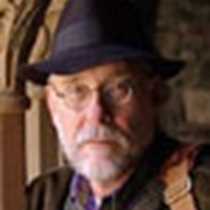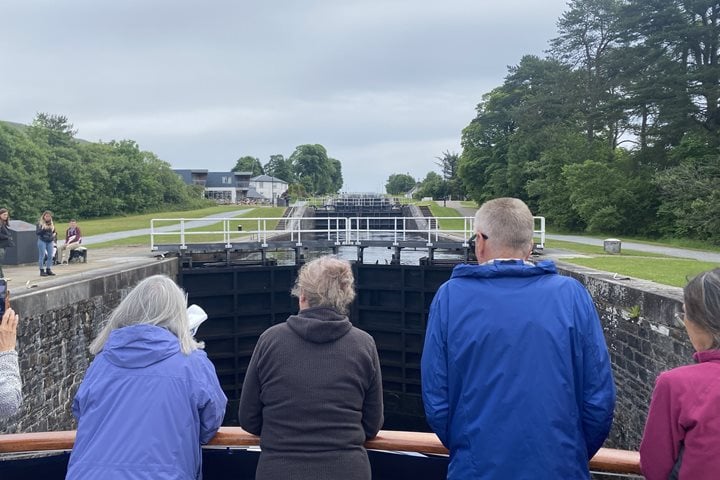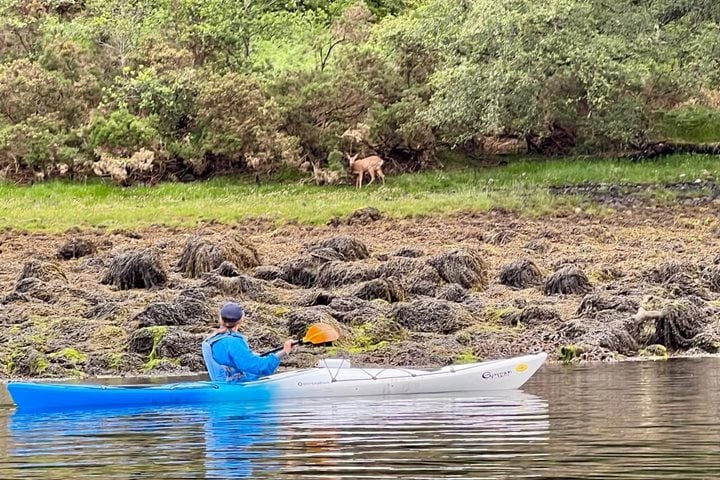Morning came early in Oban for our day of travel to Mull and the magical island of Iona. Clouds blanketed the hills of Mull as we cruised toward our docking at Craignure, where our bus waited. The driver was a gem, his running commentary a perfect match for the stunning landscape of Mull. By turn, he pointed out their stupendous rainfall (4.2 meters a year), deer on the hills, the elementary school with just five students, the scarecrow that was actually a skeleton riding a bicycle, all the movies that had been filmed in the area, and much of the island gossip—all while negotiating the one-track road and traffic that slid by, inches away. He made the long drive to Phionnphort a delight.
Iona lived up to its top billing! Our approach by short ferry ride over turquoise waters set the stage. The tiny village strung out along the beach was bathed in clear sunlight; the gentle hills beyond (where Highland cattle and their calves grazed) rose up to a brilliant blue sky. And off to the right was Iona Abbey, the focal point of our visit. So laden with history, of the coming of St. Columba from Ireland in 563, the Viking raids that wrought chaos, the building of the medieval monastery by the son of Sumerled, Lord of the Isles, and then its modern rebuilding by Rev. George Macleod, founder of the Iona religious community.
It’s a thrilling story, one that was brought to life for us first at the medieval nunnery and then at the graveyard, Relig Oran, where Scottish kings have been buried for centuries. (We looked around, wondering if we might discover the grave of MacBeth.) Outside the abbey, we stood where St. Columba had stood, saw the mound where he preached, marveled at St. Martin’s cross (dating from 800 AD and still standing), heard the creation story of the fabulous Book of Kells, feeling the presence of so much that left an indelible mark on Scottish history. Inside the restored abbey, we found a living church, with hymnals and votive candles alongside ancient relics, the church is in daily use as the worldwide spiritual home of Macleod’s Iona Community. We walked, as the monks had walked, around the cloister, the columns now carved with Scottish birds and plants.
After touring the wee, hushed museum of remnant Celtic crosses and grave slabs of knights and nuns, the sun outside dazzled us. We ate our sack lunches on benches and the grass, looking out over the bay to Mull, in supreme peacefulness.
No wonder several of us riding the ferry back to Fionnphort vowed to decamp to Iona—permanently. But not today.
We headed for Duart Castle where children were summersaulting on the lawn as we drove up. This hulking ancestral seat, strong supporters of the Lords of the Isles, came to Clan MacLean in about 1350. Standing in the courtyard, we learned that the solid castle walls around us were in ruins by 1750 and were only restored in 1912 by Sir Fitzroy Maclean. The castle then became a magnet for Macleans scattered all over the world.
From high on the parapet, we gazed out over the Sound of Mull, back toward Oban and north toward Tobermory, taking in the stunning panorama of the realm of the Lords of the Isles.







